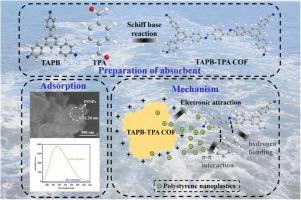聚苯乙烯纳米塑料与共价有机骨架的相互作用机理及去除性能探讨:实验与理论研究
IF 11.3
1区 环境科学与生态学
Q1 ENGINEERING, ENVIRONMENTAL
引用次数: 0
摘要
由于纳米塑料对其他污染物的吸附和结合可能增加其毒性,危害人类健康,因此纳米塑料对环境的污染引起了人们的高度关注。因此,迫切需要有效的策略来修复水生系统中的纳米塑料污染。在本研究中,实验首次使用COF去除纳米塑料。以1,3,5-三(4-氨基苯基)苯(TAPB)和对苯二醛(TPA)为原料,在常温常压下采用超声合成方法制备了TAPB-TPA COF。考察了pH、吸附剂剂量、聚苯乙烯纳米塑料(PSNPs)浓度、干扰离子和环境样品(河水、污水和海水)对PSNPs去除的影响。当ttap - tpa COF的投加量为0.3 g/L时,2 h内的去除率可达99%。实验和密度泛函理论(DFT)计算证明,静电吸引是ttap - tpa COF与psnp之间的主要吸附机制,并伴有弱化学相互作用。TAPB-TPA COF对psnp的最大吸附量接近185 mg/g,再生吸附剂仍具有良好的去除性能。本研究证明了COF作为吸附剂去除纳米塑料的可行性,为水体修复提供了理论支持。本文章由计算机程序翻译,如有差异,请以英文原文为准。

Exploration of interaction mechanism and removal performance of polystyrene nanoplastics with covalent organic framework: experimental and theoretical study
Nanoplastics pollution in the environment has attracted heightened attention due to the potential for nanoplastics to adsorb and combine with other pollutants to increase their toxicity and endanger human health. Therefore, there is an urgent demand for effective strategies to remediate nanoplastics contamination in aquatic systems. In this study, COF was experimentally used to remove nanoplastics for the first time. TAPB-TPA COF was prepared by ultrasonic synthesis method using 1,3,5-tris (4-aminophenyl) benzene (TAPB) and terephthaldehyde (TPA) at ambient temperature and pressure. The effects of pH, adsorbent dose, polystyrene nanoplastics (PSNPs) concentration, interfering ions, and environmental samples (river water, sewage and seawater) on the removal of PSNPs were investigated. A removal efficiency of 99% was attained within two hours when the dose of TAPB-TPA COF was 0.3 g/L. The experiments and density functional theory (DFT) calculations proved that electrostatic attraction between TAPB-TPA COF and PSNPs was the main adsorption mechanism, accompanied by weak chemical interactions. The maximum adsorption capacity of TAPB-TPA COF for PSNPs approached 185 mg/g and the regenerated adsorbents still had good removal performance. This work demonstrated the feasibility of COF as an adsorbent to remove nanoplastics and provided theoretical support for water remediation.
求助全文
通过发布文献求助,成功后即可免费获取论文全文。
去求助
来源期刊

Journal of Hazardous Materials
工程技术-工程:环境
CiteScore
25.40
自引率
5.90%
发文量
3059
审稿时长
58 days
期刊介绍:
The Journal of Hazardous Materials serves as a global platform for promoting cutting-edge research in the field of Environmental Science and Engineering. Our publication features a wide range of articles, including full-length research papers, review articles, and perspectives, with the aim of enhancing our understanding of the dangers and risks associated with various materials concerning public health and the environment. It is important to note that the term "environmental contaminants" refers specifically to substances that pose hazardous effects through contamination, while excluding those that do not have such impacts on the environment or human health. Moreover, we emphasize the distinction between wastes and hazardous materials in order to provide further clarity on the scope of the journal. We have a keen interest in exploring specific compounds and microbial agents that have adverse effects on the environment.
 求助内容:
求助内容: 应助结果提醒方式:
应助结果提醒方式:


